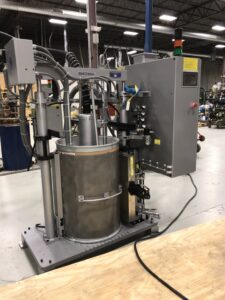Holt melt adhesives are increasingly important in modern manufacturing. They’re used in industries from textiles and furniture to food and beverage packaging, and many users are switching from solvent-based adhesives to hot melts.
and furniture to food and beverage packaging, and many users are switching from solvent-based adhesives to hot melts.
What’s behind this growth? Industry experts note that hot melts are easier to use than two-part epoxies and hold and set times can be adjusted to suit the manufacturing process. Plus, they eliminate VOC issues that cause health and safety concerns.
This growth means the hot melt dispensing systems that get the adhesive to the point of application are more important than ever. Stoppages and quality problems are inevitable if they can’t keep up with production, and those can be very expensive.
You can avoid problems like these by upgrading your hot melt dispensing systems before they become the weak link in the chain. But how can you tell when you should be taking action? Here are ten signs to look for.
1. DRUMS AREN’T BEING EMPTIED COMPLETELY
Leaving adhesive in the bottom of the drum is a waste. It wastes money, because you’ve paid for that adhesive, and it wastes time because drums are being changed more frequently than they should.
If your drum unloader is leaving 20, 30, or 40 pounds of adhesive behind, multiply that by the number of drums used per year and the price per pound. That alone might convince you it’s time to upgrade to a system that empties the drum almost completely.
2. ADHESIVE RESERVOIRS RUNNING LOW
Some adhesive dispensing systems feed a slot die head from a reservoir supplied by one or more drum unloaders. If the reservoir runs low there’s a higher risk of charring the adhesive.
Uniflow drum unloaders pump at least 40% faster.
3. DISPENSING SYSTEM CAN’T KEEP PACE WITH PRODUCTION
As production and packaging volumes increase, the dispensing system needs more pounds per hour of adhesive. If the drum unloader can’t maintain, or preferably exceed, that same rate there’s a risk of dispensing problems and possibly even quality faults in the product or packaging. The alternative is to shut down production, which with some processes is extremely expensive.
4. DRUM CHANGEOVERS ARE STOPPING PRODUCTION
How long does it take to swap out a drum?
If tanks run dry or production is paused while drums are changed, changeovers are costing you output. Perhaps you can make it up with over time, but that carries additional costs. You might consider tandem drum unloaders that will give uninterrupted output.
5. DRUM CHANGEOVER FREQUENCY IS HIGH
How many times a day are you swapping out drums?
As changeover frequency rises to match higher production rates it becomes harder to keep pace with the rate at which adhesive is used. In some cases, you can get a 10%, or more, increase in production by using tandem drum unloaders so the line does not stop for drum changes.
6. PRODUCTION/PACKAGING NEEDS A CONTINUOUS FLOW OF ADHESIVE
Many high-volume manufacturing processes, like those used with nonwovens and in printing, run continuously and at high speeds. The common solution is to pump into, and draw from, a tank.. Another solution is to upgrade the hot melt dispensing system so one drum can be changed while drawing from a second.
7. DRUM UNLOADER BREAKDOWNS ARE HITTING OUTPUT
As equipment ages, and especially if you’re working it harder than ever, breakdowns have a bigger impact on output. These unplanned stoppages are extremely disruptive to production and create a lot of additional costs. Your hot melt dispensing equipment shouldn’t be holding back output: perhaps this is a sign it’s time to upgrade.
8. THE COST OF MAINTENANCE KEEPS RISING
Check the maintenance records for your dispensing equipment. These will almost certainly show that older machinery costs more to keep running. Many businesses continue to repair worn-out units long after it would be less expensive to replace them.
9. BREAKDOWN FREQUENCY & TIME TO REPAIR ARE INCREASING
While checking maintenance spend don’t forget to look at how often the dispensing equipment needs attention and how long it takes to get it running again. If both are moving up that’s a clear sign it’s time to look at upgrading
Older machinery with proprietary components is a particular problem. If the Maintenance Department doesn’t carry a good stock of spares you could be looking at prolonged downtime while repairs are made. Don’t forget to consider your production output. Lost production is usually a higher cost than the replacement parts.
10. ENGINEERING WANTS TO SWITCH ADHESIVES
A lot of the products being made and packaging being consumed today use solvent-based adhesives. These release hazardous VOCs into the air, so businesses are looking for replacements. In many cases, this means switching to hot melt adhesives. If you see this change is on its way you definitely need to consider upgrading your hot melt dispensing systems.
DON’T BE THE BOTTLENECK
At IMMCO, we believe your hot melt dispensing systems should never hold back output. To avoid costly disruptions and quality problems they should always provide enough volume to keep production and packaging machinery running. This is especially important in an era of rising demand.
Upgrading to a Uniflow drum unloader will help you avoid problems and achieve a more efficient pumping process. Click below to see an example of how a customer experienced a 51% pump rate improvement, but that wasn’t all.


